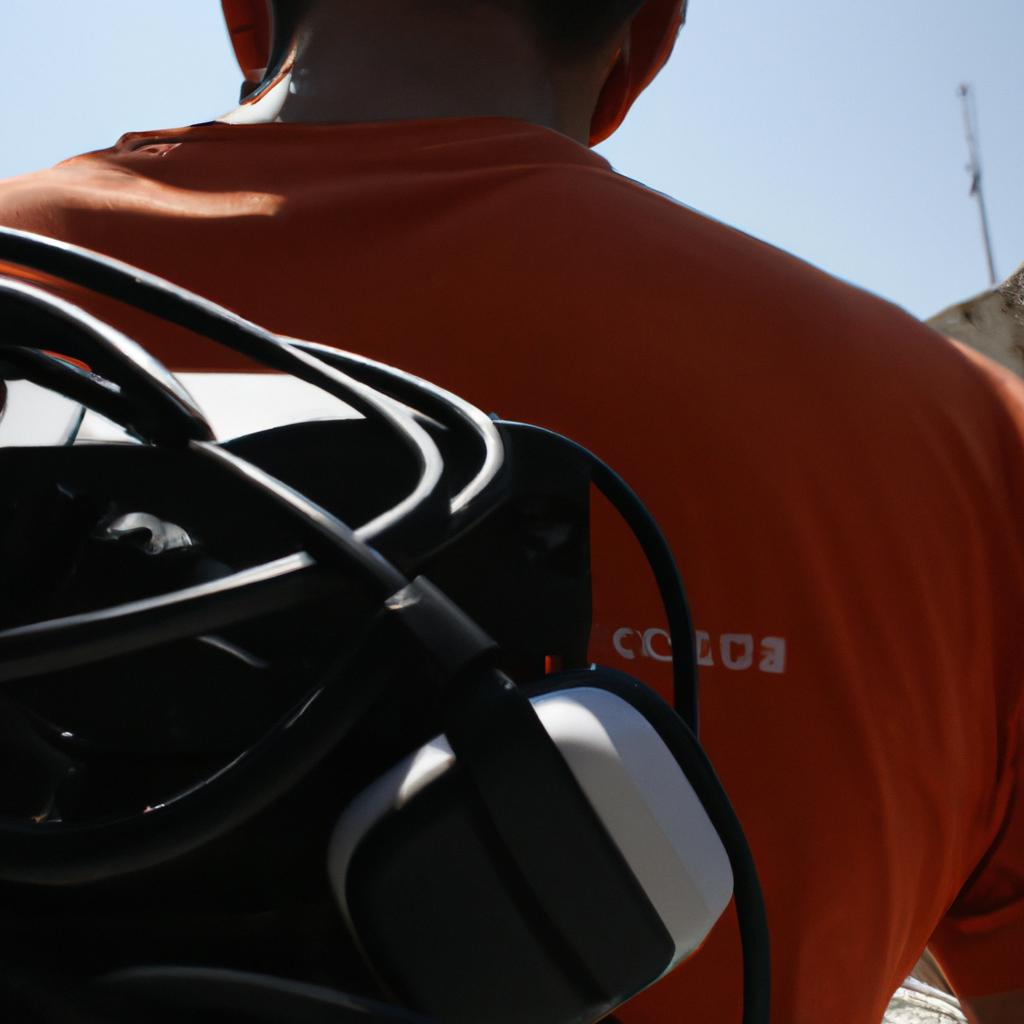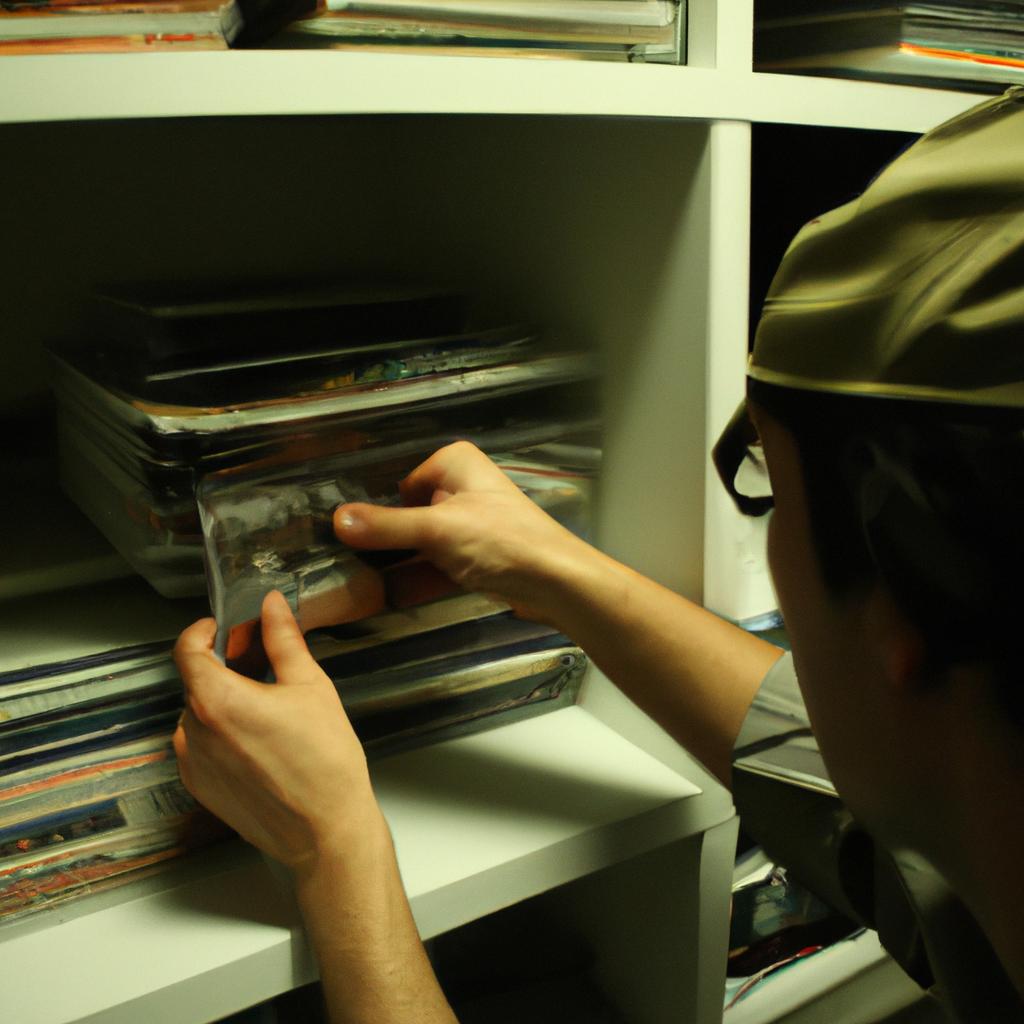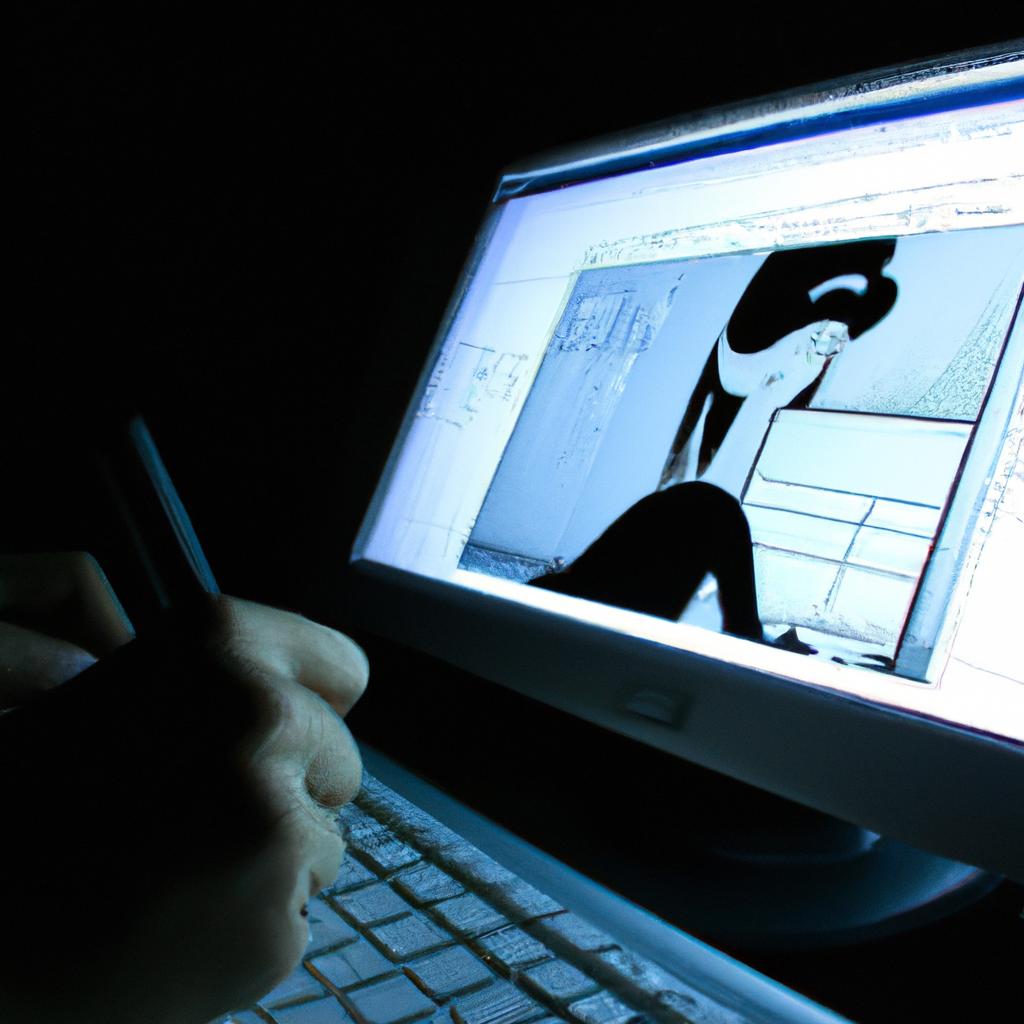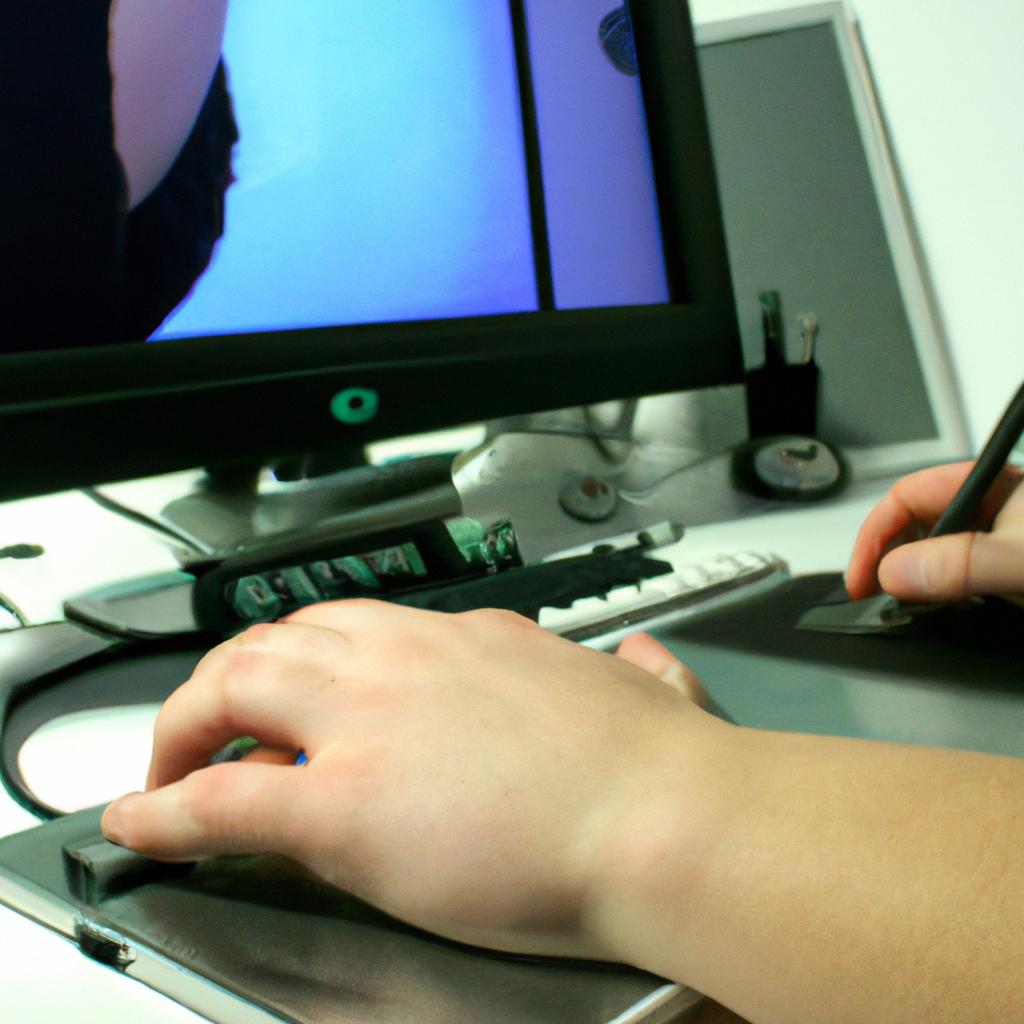In the realm of arts and television, sound design plays a crucial role in enhancing the impact and emotional resonance of documentaries. The meticulous crafting of audio elements has the power to transport viewers into the world being portrayed on screen, allowing for a more immersive experience. For instance, imagine a documentary that explores the life of an indigenous community deep within the Amazon rainforest. Through strategic use of ambient sounds such as chirping birds, rustling leaves, and distant waterfalls, coupled with carefully selected musical compositions, the audience can be transported to this remote location, evoking a sense of connection and empathy.
The artistry of sound design goes beyond mere technicalities; it is about creating an auditory landscape that complements and enhances the visual storytelling in documentaries. By skillfully manipulating sound effects, dialogue recordings, music scores, and even silence itself, sound designers have the ability to shape narratives and elicit specific emotions from viewers. Whether it is heightening tension during suspenseful moments or providing clarity through clear dialogue reproduction, every sonic decision contributes to conveying meaning and subconsciously guiding audience interpretation. As we delve deeper into understanding sound design’s role in documentary filmmaking, we will explore its various techniques and discuss how it influences our perception of reality by immersing us in a rich sonic tapestry that brings the documentary subjects and their stories to life.
One of the key techniques used in sound design is the manipulation of spatial audio. By carefully positioning sounds within the stereo or surround sound field, sound designers can create a sense of depth and dimensionality. This allows viewers to feel as if they are physically present in the documentary’s environment, whether it’s standing amidst a bustling cityscape or navigating through dense forests. The use of panning, reverb, and other spatial effects helps to immerse the audience and enhance their emotional connection to the on-screen events.
Another important aspect of sound design is the selection and placement of music. Music has the power to evoke specific emotions or set a particular mood, and when used effectively, it can greatly enhance storytelling in documentaries. Whether it’s a haunting melody that underscores a somber moment or an energetic rhythm that amplifies excitement, music serves as a powerful tool for shaping our emotional responses and creating a deeper engagement with the narrative.
Sound designers also pay close attention to dialogue recordings, ensuring that speech is clear and intelligible. In documentaries where interviews or conversations are central, it is crucial for viewers to understand what is being said without distraction. Sound designers utilize techniques such as noise reduction, equalization, and dynamic range compression to optimize dialogue clarity while maintaining a naturalistic sound.
Silence is another vital element in sound design. Strategic use of silence can be just as impactful as any other sound effect or musical cue. It can create tension before an important revelation or allow for moments of reflection and contemplation. Silence acts as a contrast to more active sounds, drawing attention to key moments and emphasizing their significance.
In conclusion, sound design plays an integral role in documentary filmmaking by immersing viewers in auditory landscapes that enhance storytelling and evoke emotional responses. Through careful manipulation of spatial audio, music selection, dialogue clarity, and even deliberate use of silence, sound designers shape our perception of reality and guide our interpretation of the documentary’s narrative.
Understanding the Importance of Sound Design in Film-making
Sound design plays a crucial role in enhancing the overall cinematic experience and storytelling in films. It encompasses the creation, manipulation, and arrangement of sound elements to convey emotions, emphasize specific aspects, and immerse audiences into the world being depicted on screen. To illustrate this point further, let us consider a hypothetical example: imagine watching a documentary about wildlife without any accompanying sounds. The absence of ambient noise like chirping birds or rustling leaves would greatly diminish the immersive quality of the film, making it less engaging for viewers.
The impact of sound design goes beyond mere entertainment value; it has the power to evoke deep emotional responses from audiences. By carefully selecting and manipulating different sound elements such as music, dialogue, foley effects, and atmospheric noises, filmmakers can create an atmosphere that resonates with viewers’ emotions. For instance:
- A suspenseful scene accompanied by tense background music and subtle environmental cues can heighten feelings of apprehension.
- Conversely, tranquil scenes featuring soothing melodies or natural sounds can induce relaxation and provide moments of respite.
- Sudden shifts in volume or jarring sound effects can startle viewers or elicit surprise.
To better understand the significance of sound design in film-making, consider the following table showcasing examples of emotional responses evoked through sound:
| Emotion | Sound Elements |
|---|---|
| Tension | Eerie music + low rumbling noises |
| Joy | Upbeat melody + laughter |
| Sadness | Melancholic soundtrack + weeping |
| Excitement | Fast-paced tempo + crowd cheering |
As evident from these examples, sound design is instrumental in conveying various emotions within a film. Furthermore, it aids in guiding audience attention towards significant visuals or narrative elements through strategic placement and manipulation of audio cues.
In conclusion (without explicitly stating so), understanding the importance of sound design in film-making is crucial for filmmakers and audiences alike. It not only enhances the overall cinematic experience but also evokes emotional responses that contribute to the immersive nature of films. In the subsequent section, we will delve into exploring the techniques employed in sound design specifically for documentaries, further highlighting its role within this genre.
[Transition sentence into the next section: Exploring the Techniques Used in Sound Design for Documentaries]
Exploring the Techniques Used in Sound Design for Documentaries
Understanding the Importance of Sound Design in Filmmaking
In filmmaking, sound design plays a crucial role in enhancing the overall cinematic experience for viewers. By creatively manipulating and combining various audio elements such as dialogue, music, and ambient sounds, filmmakers can effectively communicate emotions, set the mood, and provide additional layers of meaning to their visual storytelling. One real-life example that illustrates the significance of sound design is the documentary “Planet Earth II,” produced by the BBC Natural History Unit. Through meticulous sound editing and mixing techniques, this groundbreaking series was able to immerse audiences into the natural habitats depicted on screen.
To fully comprehend the importance of sound design in documentaries, it is essential to explore some of the techniques utilized in this domain. These techniques allow filmmakers to capture authentic audio recordings while also adding depth and coherence to their narratives. Here are some key approaches commonly employed:
- Field recording: Documentaries often require capturing real-world sounds on location to create an authentic atmosphere. This involves using high-quality microphones and recorders to capture everything from subtle environmental noises to intense action sequences.
- Foley artistry: Foley artists use everyday objects and props in a studio setting to recreate or enhance specific sounds that may not have been captured during filming. This technique adds realism and detail to a scene’s auditory landscape.
- Sound effects library: A vast collection of pre-recorded sound effects allows filmmakers access to a wide range of options when creating unique sonic experiences for their documentaries.
- Music composition: Original scores composed specifically for a documentary can profoundly impact its emotional resonance with viewers.
By incorporating these techniques into their work, documentarians can craft compelling narratives that engage both visually and sonically with their audience.
As mentioned earlier, sound design significantly contributes to enriching the narrative structure within films and documentaries alike. It functions as an invaluable tool that enhances storytelling by providing context, guiding the audience’s attention, and evoking emotional responses. In the subsequent section, we will delve deeper into how sound design actively shapes the narrative in documentaries, exploring its role as a storytelling element rather than just an accompaniment to visuals.
The Role of Sound Design in Enhancing the Narrative
Transitioning from the previous section on exploring sound design techniques used in documentaries, let us now delve into the crucial role that sound design plays in enhancing the narrative of these non-fictional works. To illustrate this point, let’s consider a hypothetical documentary called “The Power of Nature,” which explores different natural disasters and their impact on communities worldwide.
In “The Power of Nature,” the use of sound design is instrumental in creating an immersive experience for viewers. For instance, during a segment highlighting a hurricane, the sound designer incorporates howling winds, crashing waves, and creaking structures to evoke a sense of fear and impending danger. By manipulating these sounds with precision, they are able to transport audiences directly into the heart of the storm, intensifying both the visual and emotional impact.
Sound design in documentaries serves several key purposes:
- Setting the Atmosphere: Through carefully selected ambient sounds, such as chirping birds or bustling city streets, sound designers can instantly transport viewers to specific locations and time periods. This not only helps establish context but also contributes to audience immersion by recreating a realistic environment.
- Enhancing Emotions: By using music cues or subtle background noises like sighs or laughter, sound designers have the power to elicit specific emotions from viewers. Whether it be suspense, nostalgia, or empathy towards individuals’ stories within the documentary, well-crafted audio cues can significantly enhance storytelling.
- Directing Attention: Sound design aids in directing viewers’ attention to significant elements within a scene. It can highlight important dialogue through volume adjustments or emphasize certain actions through strategically placed foley effects (sounds created specifically for film). This ensures that audiences remain engaged and focused on critical aspects of the narrative.
- Providing Continuity: In post-production editing stages where footage may come from various sources or timescales, effective sound design provides cohesion and continuity throughout the documentary. Consistent audio quality ensures smooth transitions between scenes, preventing any jarring disruptions in the viewing experience.
To further illustrate these points, consider the following table:
| Sound Design Element | Purpose |
|---|---|
| Ambient Sounds | Establishes context and atmosphere |
| Music Cues | Enhances emotions and sets tone |
| Foley Effects | Directs attention and adds realism |
| Audio Quality | Provides continuity and smooth transitions |
In summary, sound design plays a vital role in shaping the narrative of documentaries. Through careful selection and manipulation of sounds, sound designers can create an immersive experience that enhances emotional impact and effectively communicates information to the audience. In our next section, we will explore how sound design can be used to create even more profound emotional impacts within documentary storytelling.
Creating Emotional Impact through Sound Design in Documentaries
Building upon the previous discussion of sound design’s role in enhancing the narrative, this section delves into how sound design creates emotional impact in documentaries. Through careful manipulation of audio elements, sound designers have the power to evoke specific emotions and heighten the viewer’s engagement with the subject matter. To illustrate this concept, let us consider a hypothetical documentary about environmental conservation efforts.
One example of how sound design can create emotional impact is through the use of ambient soundscape. In our hypothetical documentary, imagine a scene showcasing a lush rainforest teeming with life. By meticulously layering sounds of chirping birds, rustling leaves, and running water, the sound designer transports viewers into this vibrant ecosystem. The rich auditory experience envelops viewers and elicits feelings of awe and appreciation for nature’s beauty.
To further explore how sound design evokes emotions in documentaries, we can identify key techniques employed by professionals:
- Music selection: Carefully chosen musical compositions or melodies can enhance various moods within a documentary. Soft piano notes may evoke nostalgia or introspection, while intense orchestral scores can generate tension or excitement.
- Sound effects: Skillful incorporation of sound effects amplifies particular moments on screen. For instance, subtle footsteps echoing through an empty hallway can create suspense and anticipation during investigative sequences.
- Silence: Strategic use of silence can be just as powerful as any sound element. Moments devoid of background noise draw attention to significant visual cues or allow space for reflection.
Table – Emotional Impact Techniques:
| Technique | Description |
|---|---|
| Music Selection | Carefully selected music enhances mood and emotion |
| Sound Effects | Well-placed sound effects amplify certain scenes |
| Silence | Purposeful absence of sound draws focus to important visuals or thoughts |
By employing these techniques thoughtfully, skilled sound designers shape audience reactions throughout documentaries. They guide viewers’ emotional journey, fostering empathy towards subjects and strengthening the overall impact of the storytelling.
As we have explored how sound design creates emotional impact in documentaries, it is crucial to understand the collaborative nature of this process. The subsequent section will delve into the important relationship between sound designers and filmmakers, highlighting their shared vision in crafting compelling audiovisual narratives.
Collaboration between Sound Designers and Filmmakers
Building upon the idea of creating emotional impact through sound design, it is important to explore how sound designers collaborate with filmmakers to achieve this goal. By working closely together, they can effectively manipulate audio elements to enhance the storytelling experience and evoke specific emotions from the audience.
One example that illustrates the collaboration between sound designers and filmmakers is the documentary “Planet Earth.” In this remarkable series, each episode focuses on a different natural habitat around the world. The sound design team meticulously crafted immersive auditory experiences that transport viewers into these environments. For instance, when showcasing a rainforest scene, they incorporated sounds of chirping birds, rustling leaves, and distant waterfalls. These carefully selected audio cues not only provided an accurate representation of the location but also created an emotional connection for the viewers by immersing them in the sights and sounds of nature.
To further understand the role of sound design in evoking emotions within documentaries, we can consider several key aspects:
- Rhythm and pacing: The tempo and rhythm of music or ambient sounds play a vital role in setting the mood for different scenes. A fast-paced soundtrack may heighten tension during action sequences, while slow melodies create a sense of tranquility during reflective moments.
- Silence and absence: Sometimes, silence can be just as impactful as sound itself. Strategic use of silent moments can build anticipation or emphasize dramatic pauses, leaving space for reflection or emphasizing significant visuals.
- Contrast and juxtaposition: Contrasting audio elements can intensify emotions within a documentary. Pairing serene imagery with dissonant tones creates an unsettling atmosphere, while harmonious music can amplify feelings of joy or contentment.
- Symbolic associations: Certain sounds carry symbolic meanings that resonate deeply with audiences due to cultural conditioning or personal experiences. Utilizing such associations can tap into universal emotions and enhance narrative depth.
The table below provides examples of how specific techniques can evoke emotional responses in viewers:
| Technique | Emotional Response |
|---|---|
| Dynamic range | Heightened intensity |
| Foley sound | Enhanced realism |
| Sound motifs | A sense of familiarity |
| Soundscapes | Immersion and atmosphere |
By applying these techniques, sound designers have the power to transform a documentary from a mere visual experience into an emotionally engaging journey for the audience. As they continue to collaborate with filmmakers, new possibilities emerge for evoking emotions through innovative use of sound.
Transitioning into “The Future of Sound Design in the Arts and Television Industry,” it is intriguing to explore how evolving technologies and changing storytelling approaches will shape the field of sound design even further.
The Future of Sound Design in the Arts and Television Industry
Collaboration between Sound Designers and Filmmakers is crucial in creating a compelling documentary. By working together, they can enhance the overall experience for viewers by effectively using sound to convey emotions, create atmosphere, and immerse audiences into the story being told.
One example of successful collaboration between sound designers and filmmakers can be seen in the documentary “The Cove” directed by Louie Psihoyos. The film tells the story of dolphin hunting in Japan and the efforts made by activists to expose this practice. In order to capture the intensity and emotion of the subject matter, sound designer Pete Horner worked closely with Psihoyos to create a powerful audio experience. They used a combination of natural sounds such as ocean waves and dolphin calls, along with carefully selected music tracks, to heighten suspense during key moments in the film. This collaboration resulted in an immersive auditory experience that added depth and impact to the storytelling.
When it comes to sound design in documentaries, there are several key considerations that sound designers and filmmakers must take into account:
-
Emotional connection: Sound has the power to evoke strong emotional responses from viewers. By strategically using sound effects, music, and dialogue, sound designers can help shape audience perception and engagement with the content.
-
Atmosphere creation: Sound plays a vital role in setting the mood and atmosphere of a scene. From ambient sounds like city traffic or bird chirping to background music choices, every sonic element contributes to creating a cohesive audio environment that supports the narrative.
-
Storytelling through sound: Just like visuals, sound can tell its own story within a documentary. Through techniques such as voice-overs, interviews, and creative use of foley (sound effects created specifically for a scene), sound designers have the opportunity to add layers of meaning and context to what is being shown on screen.
-
Technical expertise: Collaboration between sound designers and filmmakers also involves technical aspects such as mixing, editing, and mastering audio tracks. By ensuring the technical quality of the sound design, they can deliver a seamless experience for viewers.
To further exemplify the importance of collaboration in sound design for documentaries, consider the following table:
| Documentaries | Sound Design Elements |
|---|---|
| “Blackfish” | Underwater sounds to immerse viewers into the world of killer whales. |
| “March of the Penguins” | Carefully chosen music to enhance the emotional journey of penguins braving harsh conditions. |
| “An Inconvenient Truth” | Use of climactic musical score during key moments to heighten urgency and impact. |
| “Amy” | Intimate use of archival recordings and live performances to capture Amy Winehouse’s unique voice and talent. |
In conclusion, collaboration between sound designers and filmmakers is essential in creating impactful documentaries that captivate audiences on both an intellectual and emotional level. Through careful attention to detail in sound design elements such as emotional connection, atmosphere creation, storytelling through sound, and technical expertise, these professionals work together to craft an immersive audio experience that enhances the overall narrative of a documentary film. The case study example from “The Cove” showcases how effective collaboration can result in a powerful auditory experience that supports and amplifies the messages conveyed by visual storytelling techniques.











